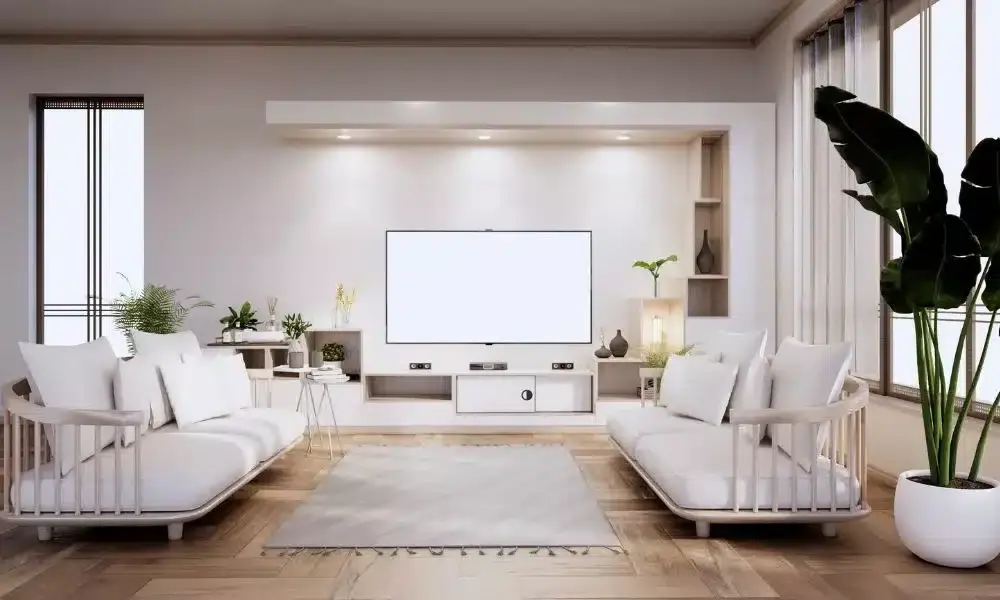White walls serve as a versatile canvas for decorating a living room, offering endless possibilities for creating a beautiful and inviting space. The purpose of this article is to provide a professional guide to effectively decorate a living room with white walls, ensuring a harmonious and visually appealing design.
Determining the Design Style
To begin, consider personal preferences and the desired atmosphere for the living room. Whether it’s a modern, minimalist, or eclectic style, researching various design styles will provide inspiration and ideas. Select a design style that complements the existing architecture and furnishings, ensuring a cohesive and balanced look.
Creating a Color Scheme
Choosing a color palette that enhances the white walls and matches the desired design style is crucial. Identify main and accent colors for furniture, accessories, and décor items. Consider the mood and ambiance associated with different colors and how they harmonize with white to create a cohesive and visually pleasing environment.
Furniture Selection and Placement
Carefully select furniture pieces that are appropriate in size and scale for the living room. Opt for furniture with colors or patterns that complement the white walls, whether it’s a neutral palette or bold accents. Arrange the furniture strategically to create functional and visually appealing seating areas, taking into account traffic flow and comfort.
Adding Texture and Patterns
Incorporating different textures through textiles such as rugs, curtains, and throw pillows adds depth and visual interest to the living room. Introduce patterns through wallpaper, upholstery, or artwork, ensuring a balanced mix that complements the white walls without overwhelming the space. The key is to maintain a cohesive look while creating a captivating atmosphere.
Statement Wall or Focal Point
Creating a statement wall with wallpaper, a mural, or an accent paint color adds character and visual impact. Alternatively, highlight a specific area or element in the living room as a focal point. Use artwork, a large mirror, or a striking piece of furniture to draw attention and create a visually captivating centerpiece.
Lighting Considerations
Assess the natural light available in the living room and use it to enhance the space. Incorporate a variety of lighting sources, including overhead lights, floor lamps, and table lamps, to provide layered illumination and create ambiance. Utilize lighting fixtures as decorative elements to add visual appeal and highlight key features.
Wall Decor and Artwork
Select artwork that complements the design style and color scheme, considering the size and scale of the white walls. Arrange artwork in a cohesive and visually pleasing manner, ensuring proper spacing and balance. Incorporate additional wall decor elements like shelves, mirrors, or clocks to add depth, interest, and personality to the room.
Window Treatments
Choose window treatments that provide privacy, light control, and aesthetic value. Consider options such as curtains, blinds, shades, or sheer panels, keeping in mind the desired design style. Coordinate window treatments with the color scheme and overall design, ensuring they enhance the beauty of the white walls.
Incorporating Plants and Greenery
Introduce indoor plants to bring life, freshness, and a pop of color to the living room. Select plants that thrive in indoor environments and require low maintenance. Place plants strategically to create focal points or fill empty corners, adding a natural and organic element to the space.
Functional Storage Solutions
Select storage furniture or decorative storage solutions that complement the design style while maximizing storage potential. Keep the living room organized and clutter-free by finding a balance between functionality and aesthetics when incorporating storage elements. Opt for stylish storage options that seamlessly blend with the overall design.
Conclusion
Decorating a living room with white walls offers endless possibilities for creating a personalized and visually stunning space. By determining the design style, creating a complementary color scheme, carefully selecting furniture and décor, incorporating texture and patterns, and considering lighting, window treatments
Read More : Simple Living Room Wall Decor Ideas

